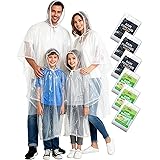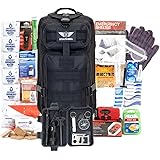Assessing Your Needs and Risks
Before diving into emergency preparedness, it’s super important to assess what you actually need. I remember the first time I tried to prepare for an emergency – I got overwhelmed with all the stuff out there. But by breaking it down, I soon realized it wasn’t as tricky!
Understanding Potential Risks
First things first, what are the risks in your area? Think about whether your location is prone to natural disasters like floods, earthquakes, or hurricanes. Even smaller risks, like power outages, can have a huge impact. From my experience, jotting this down helps you target what’s important for your situation.
Once you identify these risks, prioritize them. Make a list and rank them by what you think is most likely to happen. This can guide you on where to focus your preparedness efforts and dollars. You’d be surprised how much clarity a simple list can provide!
Finally, involve your family or housemates in this assessment. Everyone should be aware of these risks, so there’s a unified vision when it comes to preparing. Communication is key, and it makes planning a lot more fun too!
Determining Your Budget
Let’s talk money. One of the common misconceptions is that you need to spend heaps of cash to prepare for emergencies. In my experience, it’s all about smart spending. Start by setting a realistic budget based on what you can comfortably afford. Even if it’s just a few bucks a week, it adds up!
Look for places where you can trim the budget. Are there monthly subscriptions you can cut out? Or maybe adjust your grocery spending? Allocating even a little towards emergency prep can build a safety net over time without breaking the bank.
Lastly, don’t stress if your initial budget is tight. You can always adjust as you go. Remember, preparedness is a journey – it doesn’t have to happen overnight!
Building a Basic Emergency Kit
Now that you’ve assessed your needs and laid out a budget, it’s time to build that all-important emergency kit. I’ve learned over time that having these essentials can make a huge difference when you need them most.
== > What if ... Get a FREE Subscription to PREPARE
Choosing Essential Items
Start with the basics. You’ll want food, water, first-aid supplies, clothing, and shelter items. I recommend looking for non-perishable food items like canned goods or freeze-dried meals that can last. For water, a lot of people don’t realize that about a gallon per person per day is usually sufficient.
When it comes to a first-aid kit, make sure it includes band-aids, antiseptic wipes, and any medications your family might need. Over time, as I’ve gotten more experienced, I’ve added unique items that have become essential for our household!
Consider customizing your kit based on your family’s needs. For example, if you have pets, include food and supplies for them too. Being prepared doesn’t have to be one-size-fits-all – make it personal!
DIY vs. Store-Bought Supplies
This is where you can really save some cash. I’ve often found that making my supplies can be both cost-effective and satisfactory. For instance, instead of buying a pre-packaged first-aid kit, why not gather your own supplies? It can be fun to create something that fits your specific needs!
Certainly, there are items best bought pre-made, especially those that require lengthy production processes like water filtration systems. Learning to distinguish between what to make and what to buy is an essential part of the process.
Plus, there’s a certain pride in knowing you’ve assembled your own emergency kit! It makes it feel more tailored and meaningful, which is something you don’t always get with store-bought options.
Educating Yourself and Your Family
I can’t stress enough how important it is to educate yourself and your family about emergency preparedness. This is one area where knowledge really is power!
Learning Emergency Skills
Take the opportunity to learn basic first-aid, CPR, and fire safety. There are so many free resources online. I also found local community classes that teach skills like survival techniques, and trust me, they’re worth the investment!
Once you’ve got those skills down, practice them. Make it a regular thing to check in on what your family remembers and update them on any new techniques or tools. Keeping these skills fresh is vital!
Do some family drills too! It can be as simple as practicing how to escape your home during a fire or discussing what to do during a severe weather event. Knowing everyone’s role can be super calming during actual emergencies.
Staying Informed
Part of being prepared is staying updated. Set up alerts on your phone for local emergency situations, and tune in to community meetings when you can. I always make time for these, as they’re often invaluable sources of local knowledge.
The more you understand the resources available in your community, the better off you’ll be. Get to know your local emergency services and what they provide. They can be an excellent support system during crises.
Remember, preparedness doesn’t just mean having supplies; it means knowing how to effectively use them in a real-life situation!
Implementing a Plan for Action
Having a great stack of supplies is neat, but if you don’t have a plan, it’s not doing you much good. I’ve learned the hard way that it’s about more than just having stuff on hand!
Creating a Family Emergency Plan
Gather everyone and draft a solid family emergency plan. This plan should include communication strategies, meeting points, and roles for each individual. I remember we wrote our plan out on a big sheet of paper and posted it on the fridge, so we all see it often!
Your plan should cater to different scenarios too, whether it’s a severe weather event or a medical emergency. Review it regularly, as this keeps everyone engaged and informed. Adjusting your plan as personal circumstances change is just as important.
Don’t forget to include a “Go Bag” with essential items, so you can grab it at a moment’s notice! It makes a world of difference when things unexpected happen.
Practicing Your Plan
Just like with learning skills, practice is vital. Go over your emergency plan together in a relaxed environment. Role-play different scenarios, so the first time something happens isn’t when you’re in a panic. The calmness this brings is incredible!
During practice runs, make note of what works and what doesn’t. It can be really eye-opening to see how the plan plays out in reality; you may need to reevaluate and change strategies accordingly.
This practice also serves to alleviate fears. Kids especially can benefit from knowing what steps they’ll take in a given situation. It turns anxiety into confidence, which is key when push comes to shove.
Conclusion
Preparing for emergencies on a budget is absolutely achievable! By assessing needs, building a basic kit, educating yourself, and implementing a solid plan, you can be prepared without breaking the bank. Spread the word, involve your loved ones, and remember – every little bit counts!
Frequently Asked Questions
1. What items should I prioritize for my emergency kit?
Focus on essentials like non-perishable food, water, a first-aid kit, clothing, and shelter-related items. Tailoring your kit for your unique needs, including items for pets or specific medications, is crucial.
2. Can I really prepare without spending a lot?
Absolutely! You can start small, utilizing what you already have and gradually building your supplies over time. It’s about being resourceful and smart with your budget.
3. How can my family be involved in the planning?
Include everybody in discussions about risks, brainstorming, and practice runs. This creates a team effort, making everyone feel important and engaged in the process.
4. Are DIY emergency kits effective?
Yes! Assembling your own emergency kit can be not only cost-effective, but it also allows you to customize supplies to fit your specific needs better than pre-made kits.
5. How often should we review our emergency plan?
Regularly reviewing your emergency plan is crucial – at least every six months or after major life changes. This keeps the information fresh and relevant.
Related Content
Genuine USGI Individual MRE [Meal, Ready to Eat] Inspection Date 01/2024 or Newer - You Choose Menu - Complete Ration with Entree, Snacks, Dessert, Drink Mix, Utensils, Condiments and FRH. (#4 Spaghetti)
$13.85 (as of December 18, 2025 17:11 GMT -05:00 - More infoProduct prices and availability are accurate as of the date/time indicated and are subject to change. Any price and availability information displayed on [relevant Amazon Site(s), as applicable] at the time of purchase will apply to the purchase of this product.)Hitituto Rain Ponchos Family Pack Kids– 6/12/24 Pack Disposable Poncho with Hood, Clear & Assorted Colors, Home Survival Kits
$8.49 (as of December 18, 2025 17:11 GMT -05:00 - More infoProduct prices and availability are accurate as of the date/time indicated and are subject to change. Any price and availability information displayed on [relevant Amazon Site(s), as applicable] at the time of purchase will apply to the purchase of this product.)Stealth Angel Survival - 72 Hour Family Emergency Kit - 1-5 Person Survival Bag for Earthquakes, Hurricanes, and Other Natural Disasters
Now retrieving the price.
(as of December 18, 2025 17:11 GMT -05:00 - More infoProduct prices and availability are accurate as of the date/time indicated and are subject to change. Any price and availability information displayed on [relevant Amazon Site(s), as applicable] at the time of purchase will apply to the purchase of this product.)





